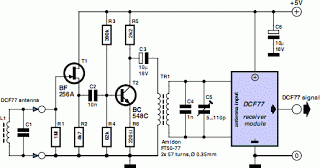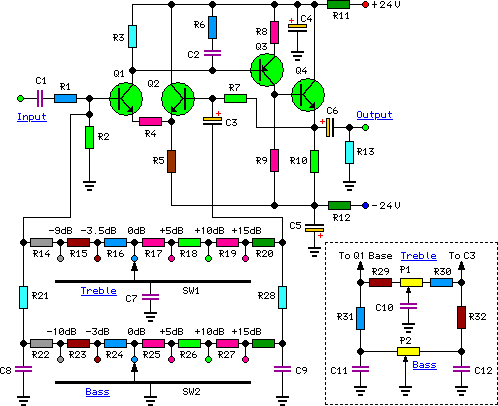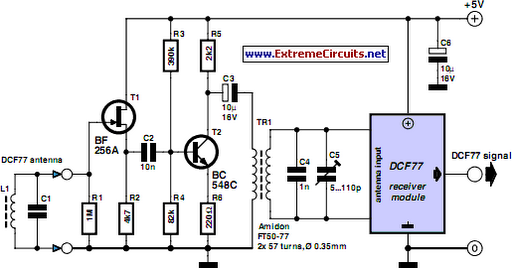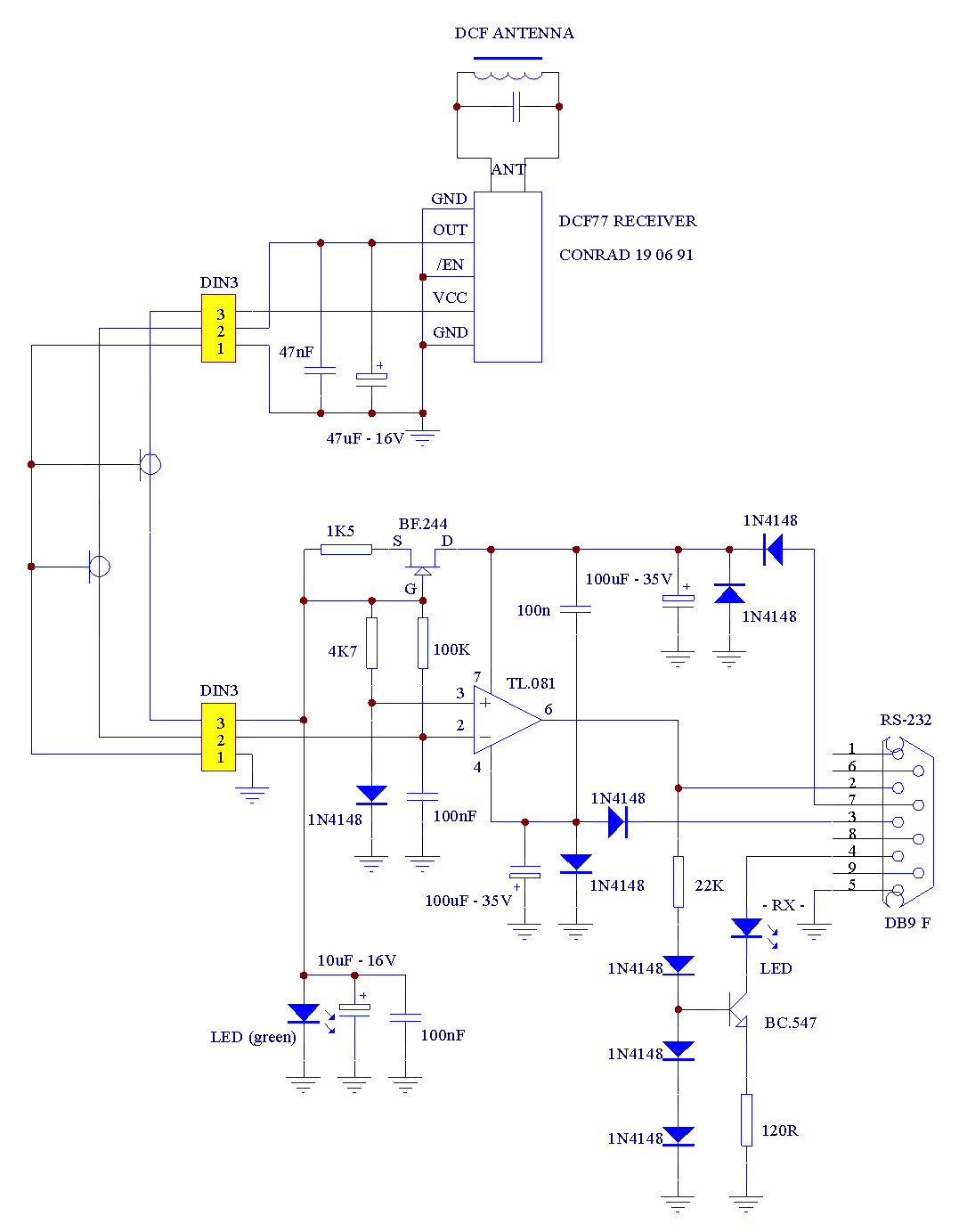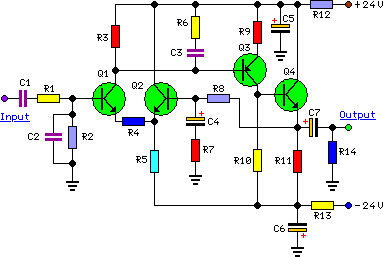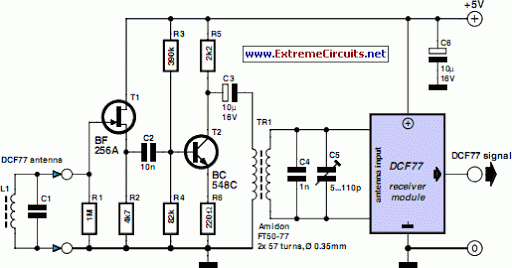
PreamplifierCircuit DCF77
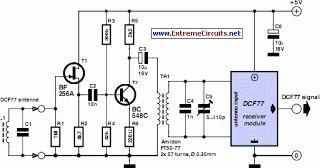
DCF77 Preamplifier Circuit Diagram A popular project among microcontroller enthusiasts is to build a radio-controlled clock. Small receiver boards are available, equipped with a pre-adjusted ferrite antenna, that receive and demodulate the DCF77 time signal broadcast from Mainflingen in Germany. DCF77 has a range of approximately 1,000 miles. All that is required from the microcontroller is to decode the signal and display the results. The quality of reception achieved by these pre-manufactured boards generally correlates with their price. In areas with marginal reception, a higher quality receiver is necessary, and a small selective preamplifier stage typically enhances performance. The original ferrite antenna is desoldered from the receiver module and connected to the preamplifier's input. This input features a source follower (T1) that has minimal damping effect on the resonant circuit. A bipolar transistor (T2) provides approximately 5 dB of gain. The output signal is coupled to the antenna input of the DCF77 module via a transformer. The secondary of the transformer, along with capacitors C4 and C5, forms a resonant circuit that must be tuned to center on the carrier frequency. An oscilloscope is required for this adjustment, and a signal generator set to produce a 77.5 kHz sine wave is also beneficial. This signal is introduced, at an amplitude of a few millivolts, into the antenna input. With the oscilloscope connected across C4 and C5 to monitor the output resonant circuit signal, trimmer capacitor C5 is adjusted until maximum amplitude is observed. It is crucial that the transformer used is suitable for constructing a resonant circuit at the carrier frequency. The prototype utilized an FT50-77 core from Amidon, on which two 57-turn windings were made. It is also possible to adjust the resonant frequency of the circuit using a transformer with an adjustable core. In this scenario, the trimmer capacitor may be omitted.
The DCF77 preamplifier circuit is designed to enhance the reception of the DCF77 time signal, which is crucial for applications such as radio-controlled clocks. The circuit utilizes a combination of a source follower and a bipolar transistor to amplify the weak signals received by the ferrite antenna.
The source follower (T1), which is the first stage of the preamplifier, serves to buffer the input signal while presenting a high input impedance and low output impedance. This configuration allows for minimal signal loss and ensures that the resonant characteristics of the antenna are preserved. The bipolar transistor (T2) provides additional gain to the signal, amplifying it by approximately 5 dB. This gain is significant for improving the signal-to-noise ratio, especially in areas where the DCF77 signal may be weak or distorted.
The transformer used in the circuit is a critical component, as it couples the amplified signal to the DCF77 module while also forming part of the resonant circuit with capacitors C4 and C5. This resonant circuit must be precisely tuned to the carrier frequency of 77.5 kHz to ensure optimal performance. The tuning process involves using an oscilloscope to monitor the output signal across the capacitors while adjusting the trimmer capacitor (C5) for maximum amplitude.
The choice of transformer is also important; it must be capable of resonating at the desired frequency without introducing significant losses. The FT50-77 core from Amidon, used in the prototype, is a suitable choice due to its characteristics, which allow for effective winding configurations. The circuit can also accommodate transformers with adjustable cores, providing flexibility in tuning without the need for a trimmer capacitor.
Overall, the DCF77 preamplifier circuit is a well-engineered solution for enhancing the reception of time signals, making it an essential component for reliable operation of radio-controlled clocks. Proper assembly and tuning of the circuit will yield improved performance and accuracy in timekeeping applications.DCF77 Preamplifier Circuit DiagramA popular project among microcontroller aficionados is to build a radio-controlled clock. Tiny receiver boards are available, with a pre-adjusted ferrite antenna, that receive and demodulate the DCF77 time signal broadcast from Mainf lingen in Germany.
DCF77 has a range of about 1, 000 miles. All the microcontrolle r need do is decode the signal and output the results on a display. The reception quality achieved by these ready-made boards tends to be proportional to their price. In areas of marginal reception a higher quality receiver is needed, and a small selective preamplifier stage will usually improve the situation further. The original ferrite antenna is desoldered from the receiver module and connected to the input of the preamplifier.
This input consists of a source follower (T1) which has very little damping effect on the resonant circuit. A bipolar transistor (T2) provides a gain of around 5 dB. The output signal is coupled to the antenna input of the DCF77 module via a transformer. DCF77 Preamplifier Circuit Diagram The secondary of the transformer, in conjunction with capacitors C4 and C5, forms a resonant circuit which must be adjusted so that it is centered on the carrier frequency.
An oscilloscope is needed for this adjustment, and a signal generator, set to generate a 77. 5 kHz sine wave, is also very useful. This signal is fed, at an amplitude of a few milli-volts, into the antenna input. With the oscilloscope connected across C4 and C5 to monitor the signal on the output resonant circuit, trimmer C5 is adjusted until maximum amplitude is observed. It is essential that the transformer used is suitable for constructing a resonant circuit at the carrier frequency.
Our proto-type used a FT50-77 core from Amidon on which we made two 57-turn windings. It is also possible to trim the resonant frequency of the circuit by using a transformer whose core can be adjusted in and out. In this case, of course, the trimmer capacitor can be dispensed with. Rainer Reusch Elektor Electronics 2008 🔗 External reference
The DCF77 preamplifier circuit is designed to enhance the reception of the DCF77 time signal, which is crucial for applications such as radio-controlled clocks. The circuit utilizes a combination of a source follower and a bipolar transistor to amplify the weak signals received by the ferrite antenna.
The source follower (T1), which is the first stage of the preamplifier, serves to buffer the input signal while presenting a high input impedance and low output impedance. This configuration allows for minimal signal loss and ensures that the resonant characteristics of the antenna are preserved. The bipolar transistor (T2) provides additional gain to the signal, amplifying it by approximately 5 dB. This gain is significant for improving the signal-to-noise ratio, especially in areas where the DCF77 signal may be weak or distorted.
The transformer used in the circuit is a critical component, as it couples the amplified signal to the DCF77 module while also forming part of the resonant circuit with capacitors C4 and C5. This resonant circuit must be precisely tuned to the carrier frequency of 77.5 kHz to ensure optimal performance. The tuning process involves using an oscilloscope to monitor the output signal across the capacitors while adjusting the trimmer capacitor (C5) for maximum amplitude.
The choice of transformer is also important; it must be capable of resonating at the desired frequency without introducing significant losses. The FT50-77 core from Amidon, used in the prototype, is a suitable choice due to its characteristics, which allow for effective winding configurations. The circuit can also accommodate transformers with adjustable cores, providing flexibility in tuning without the need for a trimmer capacitor.
Overall, the DCF77 preamplifier circuit is a well-engineered solution for enhancing the reception of time signals, making it an essential component for reliable operation of radio-controlled clocks. Proper assembly and tuning of the circuit will yield improved performance and accuracy in timekeeping applications.DCF77 Preamplifier Circuit DiagramA popular project among microcontroller aficionados is to build a radio-controlled clock. Tiny receiver boards are available, with a pre-adjusted ferrite antenna, that receive and demodulate the DCF77 time signal broadcast from Mainf lingen in Germany.
DCF77 has a range of about 1, 000 miles. All the microcontrolle r need do is decode the signal and output the results on a display. The reception quality achieved by these ready-made boards tends to be proportional to their price. In areas of marginal reception a higher quality receiver is needed, and a small selective preamplifier stage will usually improve the situation further. The original ferrite antenna is desoldered from the receiver module and connected to the input of the preamplifier.
This input consists of a source follower (T1) which has very little damping effect on the resonant circuit. A bipolar transistor (T2) provides a gain of around 5 dB. The output signal is coupled to the antenna input of the DCF77 module via a transformer. DCF77 Preamplifier Circuit Diagram The secondary of the transformer, in conjunction with capacitors C4 and C5, forms a resonant circuit which must be adjusted so that it is centered on the carrier frequency.
An oscilloscope is needed for this adjustment, and a signal generator, set to generate a 77. 5 kHz sine wave, is also very useful. This signal is fed, at an amplitude of a few milli-volts, into the antenna input. With the oscilloscope connected across C4 and C5 to monitor the signal on the output resonant circuit, trimmer C5 is adjusted until maximum amplitude is observed. It is essential that the transformer used is suitable for constructing a resonant circuit at the carrier frequency.
Our proto-type used a FT50-77 core from Amidon on which we made two 57-turn windings. It is also possible to trim the resonant frequency of the circuit by using a transformer whose core can be adjusted in and out. In this case, of course, the trimmer capacitor can be dispensed with. Rainer Reusch Elektor Electronics 2008 🔗 External reference
